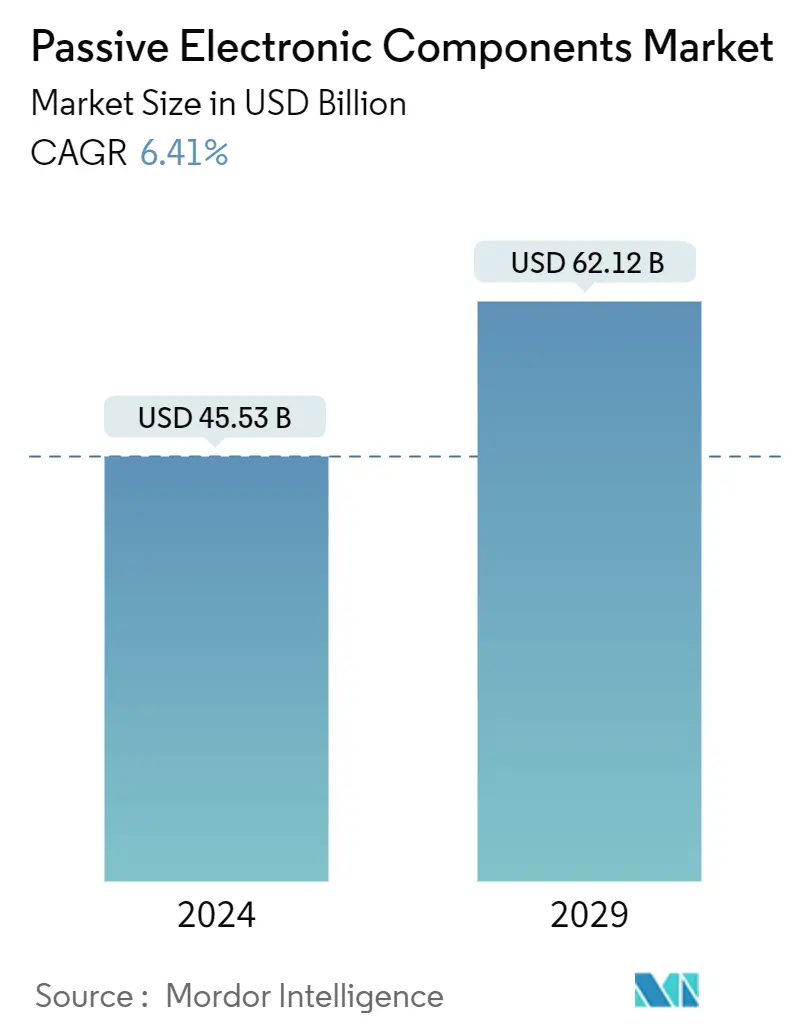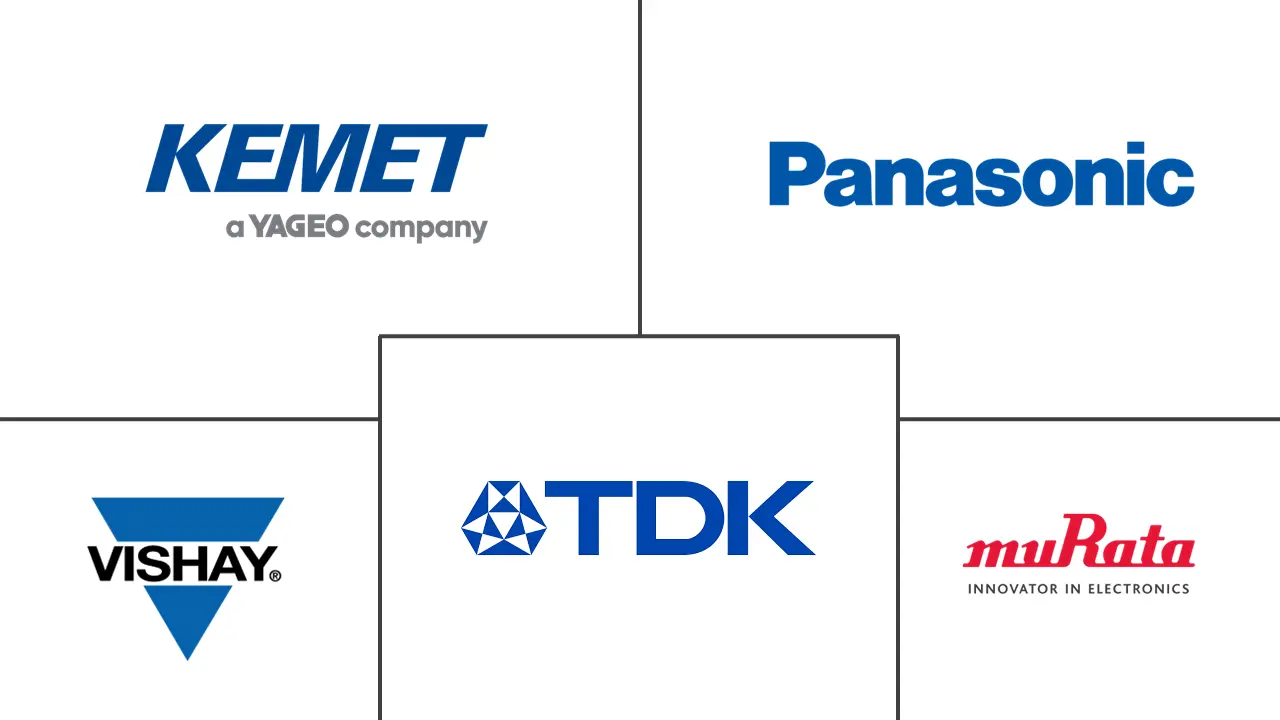Market Size of Passive Electronic Components Industry

| Study Period | 2019-2029 |
| Market Size (2024) | USD 45.53 Billion |
| Market Size (2029) | USD 62.12 Billion |
| CAGR (2024 - 2029) | 6.41 % |
| Fastest Growing Market | Asia Pacific |
| Largest Market | Asia-Pacific |
| Market Concentration | Low |
Major Players
*Disclaimer: Major Players sorted in no particular order |
Passive Electronic Components Market Analysis
The Passive Electronic Components Market size is estimated at USD 45.53 billion in 2024, and is expected to reach USD 62.12 billion by 2029, growing at a CAGR of 6.41% during the forecast period (2024-2029).
Passive electronic components are the cornerstone of all electronics, in physical design and circuit models' language, representing electrical behavior in complicated systems. Integrated circuits include these components, and circuit boards contain discrete passive components. The increasing demand for electronic devices is anticipated to boost the passive electronic components market's growth.
- The growth of inductors is presently steady, owing to the increasing number of product launches, the developments in the consumer electronics sector, the rising use of inductors in automotive electronics, and the adoption of smart grids. Globally, the rising demand for consumer electronics, such as tablets, smartphones, laptops, set-top boxes, and portable gaming consoles, is the major factor boosting the need for inductors.
- With the advent of technological advancements, electronics, and electronic devices are getting more complex, primarily due to the increasing consumer demand for small or slim devices. Customers have a specific standard for these devices nowadays, such as a sleek, thin design, with the screen going from edge to edge.
- Moreover, smartphones have witnessed the great success of MEMS gyroscopes owing to their low cost, miniature size, and lightweight nature. Features like voice-enabled smart devices have also been witnessing increased adoption over the past few years. The adoption of smart devices, such as the Amazon Echo, Google Home, and Sonos, was estimated to be aggressive by the end of 2023. The younger generation views these devices as the smarter, faster, and easier way to perform everyday activities.
- The adoption of wearables in the healthcare sector has been gaining traction in recent times, which, in turn, has been one of the significant factors influencing the market studied. The major trends in wearable connected devices include the increasing demand for pain management wearable devices and the increasing use of wearables for cardiovascular disease management.
- As nickel is an essential element for steel industries and, therefore, crucial to industrial countries, in recent times, the price of the element has been most affected by continuing lockdowns in some parts of the world, coupled with supply-side restraints. Indonesia, the largest miner and nickel exporter, banned metal exports in the hopes of a price rise in the wake of limited supplies to China.
- The COVID-19 pandemic led to immense disruptions in supply chains across industries globally. Many businesses globally halted or reduced operations to help combat the spread of the virus. The pandemic impacted the passive electronic components market, leading to decreased operation levels across the supply chain on the raw material and component production levels. This denoted a fall in sales in a range of regions and countries.
- The demand from consumer electronics industries has increased post-pandemic and is anticipated to boost the demand in the passive electronic components market. For instance, according to the industry body India Cellular and Electronics Association (ICEA), smartphone exports in the April 2022-February 2023 years doubled from a year ago when exports hovered around USD 4.5 billion. In addition, India's mobile phone exports crossed USD 2 billion in the first two months of 2023, driven mainly by Apple and Samsung, taking the entire export value to over USD 9 billion since April 2022, as manufacturers stepped up production and external shipments.
Passive Electronic Components Industry Segmentation
Passive electronic components are components that consume energy. They do not produce energy, are incapable of power gain, and require no electrical power to operate. They simply absorb energy. A standard example of passive electronic components would be resistors, inductors, and capacitors. The analysis is based on the market insights captured through secondary research and through the primaries. The market also covers the major factors impacting the growth of the passive electronic components market in terms of drivers and restraints.
The passive electronic components market is segmented by capacitors, inductors, and resistors.
Capacitors are further segmented by type (ceramic capacitors, tantalum capacitors, aluminum electrolytic capacitors, paper and plastic film capacitors, and supercapacitors), end-user industry (automotive, consumer electronics, aerospace and defense, energy, communications/servers/data storage, industrial, and medical), and geography (Americas, Europe, Middle East and Africa, Asia-Pacific (excl. Japan and Korea), and Japan and South Korea).
Inductors are further segmented by type (power and frequency), end-user industry (automotive, consumer electronics and computing, aerospace and defense, and communications), and geography (North America, Europe, Asia-Pacific, and the Rest of the World).
Resistors are further segmented by type (surface-mounted chips, networks, wire-wound, film/oxide/foil, carbon), end-user industry (automotive, consumer electronics and computing, aerospace and defense, and communications), and geography (North America, Europe, Asia-Pacific, and Rest of the World).
The report offers market forecasts and size in value (USD) for all the above segments.
| Capacitors | |||||||||
| |||||||||
| |||||||||
|
| Inductors | |||||||
| |||||||
| |||||||
|
| Resistors | |||||||
| |||||||
| |||||||
|
Passive Electronic Components Market Size Summary
The passive electronic components market is poised for significant growth, driven by the increasing demand for electronic devices across various sectors. These components, which include inductors, capacitors, and resistors, are integral to the functioning of electronic circuits and systems. The market is experiencing a steady expansion due to the rising adoption of consumer electronics, such as smartphones, tablets, and laptops, as well as the growing integration of these components in automotive electronics and smart grids. The trend towards miniaturization and the demand for sleek, high-performance devices are further propelling the market forward. Additionally, the healthcare sector's increasing reliance on wearables for health monitoring is contributing to the market's growth trajectory.
The Asia-Pacific region is a key driver of the passive electronic components market, with countries like China, Japan, and South Korea leading in consumer electronics production and innovation. The region's robust demand for smart appliances and high-end products is expected to sustain the market's growth. The market is characterized by the presence of major players such as Delta Electronics Inc., Panasonic Corporation, TDK Corporation, Vishay Intertechnology Inc., and Murata Manufacturing Co. Ltd., who are actively engaging in strategic partnerships and product innovations to maintain a competitive edge. Recent developments, such as TDK's launch of high-efficiency power inductors and Vishay's new series of wet tantalum capacitors, highlight the ongoing advancements in the industry. These innovations are aimed at enhancing the performance and reliability of electronic devices, thereby supporting the market's expansion in the coming years.
Passive Electronic Components Market Size - Table of Contents
-
1. MARKET INSIGHTS
-
1.1 Market Overview
-
1.2 Industry Attractiveness - Porter's Five Forces Analysis
-
1.2.1 Bargaining Power of Suppliers
-
1.2.2 Bargaining Power of Buyers
-
1.2.3 Threat of New Entrants
-
1.2.4 Threat of Substitutes
-
1.2.5 Degree of Competition
-
-
1.3 Industry Value Chain Analysis
-
1.4 Impact of COVID-19 and Other Macroeconomic Factors on the Market
-
1.5 Demand and Supply of Palladium and Ruthenium Till 2022 and Forecast for 2023
-
-
2. MARKET SEGMENTATION
-
2.1 Capacitors
-
2.1.1 By Type
-
2.1.1.1 Ceramic Capacitors
-
2.1.1.2 Tantalum Capacitors
-
2.1.1.3 Aluminum Electrolytic Capacitors
-
2.1.1.4 Paper and Plastic Film Capacitors
-
2.1.1.5 Supercapacitors
-
-
2.1.2 By End-user Industry
-
2.1.2.1 Automotive
-
2.1.2.2 Industrial
-
2.1.2.3 Aerospace and Defense
-
2.1.2.4 Energy
-
2.1.2.5 Communications/Servers/Data Storage
-
2.1.2.6 Consumer Electronics
-
2.1.2.7 Medical
-
-
2.1.3 By Geography
-
2.1.3.1 Americas
-
2.1.3.2 Europe, Middle East and Africa
-
2.1.3.3 Asia-Pacific (Excl. Japan and Korea)
-
2.1.3.4 Japan and South Korea
-
-
-
2.2 Inductors
-
2.2.1 By Type
-
2.2.1.1 Power
-
2.2.1.2 Frequency
-
-
2.2.2 By End-user Industry
-
2.2.2.1 Automotive
-
2.2.2.2 Aerospace and Defense
-
2.2.2.3 Communications
-
2.2.2.4 Consumer Electronics and Computing
-
2.2.2.5 Other End-user Industries
-
-
2.2.3 By Geography
-
2.2.3.1 North America
-
2.2.3.2 Europe
-
2.2.3.3 Asia-Pacific
-
2.2.3.4 Rest of the World
-
-
-
2.3 Resistors
-
2.3.1 By Type
-
2.3.1.1 Surface-mounted Chips
-
2.3.1.2 Network
-
2.3.1.3 Wirewound
-
2.3.1.4 Film/Oxide/Foil
-
2.3.1.5 Carbon
-
-
2.3.2 By End-user Industry
-
2.3.2.1 Automotive
-
2.3.2.2 Aerospace and Defense
-
2.3.2.3 Communications
-
2.3.2.4 Consumer Electronics and Computing
-
2.3.2.5 Other End-user Industries
-
-
2.3.3 By Geography
-
2.3.3.1 North America
-
2.3.3.2 Europe
-
2.3.3.3 Asia-Pacific
-
2.3.3.4 Rest of the World
-
-
-
Passive Electronic Components Market Size FAQs
How big is the Passive Electronic Components Market?
The Passive Electronic Components Market size is expected to reach USD 45.53 billion in 2024 and grow at a CAGR of 6.41% to reach USD 62.12 billion by 2029.
What is the current Passive Electronic Components Market size?
In 2024, the Passive Electronic Components Market size is expected to reach USD 45.53 billion.

